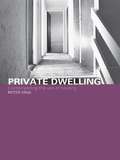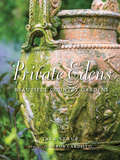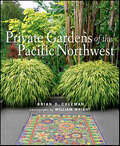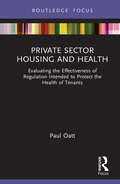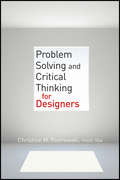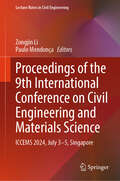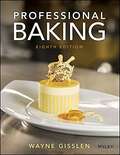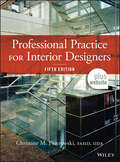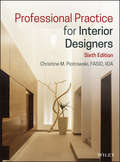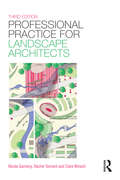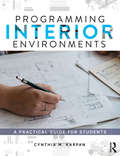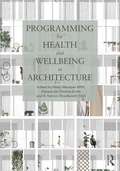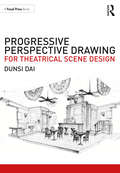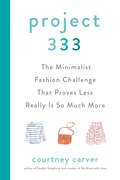- Table View
- List View
Principles of Ecological Landscape Design
by Travis BeckToday, there is a growing demand for designed landscapes--from public parks to backyards--to be not only beautiful and functional, but also sustainable. With Principles of Ecological Landscape Design, Travis Beck gives professionals and students the first book to translate the science of ecology into design practice. This groundbreaking work explains key ecological concepts and their application to the design and management of sustainable landscapes. It covers topics from biogeography and plant selection to global change. Beck draws on real world cases where professionals have put ecological principles to use in the built landscape. For constructed landscapes to perform as we need them to, we must get their underlying ecology right. Principles of Ecological Landscape Design provides the tools to do just that.
Principles of Element Design
by Yvonne Dean Peter RichThe construction of buildings is learnt through experience and the inheritance of a tradition in forming buildings over several thousand years. Successful construction learns from this experience which becomes embodied in principles of application. Though materials and techniques change, various elements have to perform the same function. 'Principles of Element Design' identifies all the relevant elements and then breaks these elements down into all their basic constituents, making it possible for students to fully understand the given theory and principles behind each part. As all building projects are subject to guidance through the Building Regulations and British Standards, this book gives an immediate reference back to relevant information to help practitioners and contractors identify key documents needed.Yvonne Dean B.A. (Hons) B.A (Open) RIBA, an architect, energy consultant and materials technologist. She also has 15 years experience as a lecturer, travels widely and is a guest lecturer at many universities. She pioneered an access course for Women into Architecture and Building, which has been used as a template by others, and has been instrumental in helping to change the teaching of technology for architects and designers.Peter Rich AA Dipl. (Hons) Architect, started his career with 14 years experience as a qualified architectural technician. He then joined the AA School of Architecture, working with Bill Allen and John Bickerdike after his graduation, later becoming a partner of Bickerdike Allen Rich and Partners. He also taught building construction at the Bartlett School of Architecture, University College London, and architectural design at the Polytechnic of North London. He now acts as a Consultant.
Principles of Style
by Sarah AndrewsIn Principles of Style, Sarah Andrews presents her unique take on teaching design, drawing on her experience of working in the industry and as a teacher in her school, which has reached cult status around the world. Importantly, Principles of Style aims to be a timeless learning tool for readers, no matter their own personal style, with Sarah revealing many of the ideas, tips and skills she has accumulated along the way. She does this by examining some of her key projects and favourite rooms, as well as by focusing on her ten rules of styling, formulated both through hands-on experience and studies in the science of design. Sarah believes that everyone has the ability to create interiors that are right for them; in this inspiring and eminently practical book, she aims to demonstrate just how to do so.
Principles of Victorian Decorative Design (Dover Architecture)
by Christopher DresserClassic by noted Victorian designer discusses aesthetics, practical considerations of Victorian and Edwardian design. Rich, illuminating treatment of historic styles, beauty, utility, design of furniture, carpets, draperies, textiles, pottery, glass, metalwork, many other elements. Over 180 handsome illustrations.
Printmaking: How to Print Anything on Everything
by Christine MedleyBefore the digital age, printing was a handcraft — and it still is! This guide presents 12 easy-to-follow projects that demonstrate time-honored techniques for decorating gift bags and coasters, transferring images to mugs and t-shirts, and embellishing other items. Suitable for crafters at all levels of ability and of all ages, the projects employ common household items such as cardboard tubes, cork, and rubber erasers. More than 100 photographs accompany complete directions for the easy and accessible process of relief printing: creating a stencil, inking it up, applying the stencil to the item, and then repeating. An introduction to tools, materials, and equipment is followed by chapters on making your own toolbox, creating art with found and natural objects, printing with your own custom stamps and plates, screen printing and photographic techniques, and more. Each project features helpful tips for turning out a high-quality product and suggestions for adding personal touches.
Printreading for Residential Construction, Sixth Edition
by Thomas E. Proctor Leonard P. ToenjesPrintreading for Residential Constructionpresents printreading fundamentals and provides printreading activities related to residential construction. Topics presented include sketching, computer-aided design (CAD), trade math symbols and abbreviations, plot plans, floor plans, elevations, sections, and details. This new edition provides information on revised building codes, LEED for Homes, green building practices, advanced house framing techniques, insulation, and the whole-house systems approach. Content Overview Construction Documents Working Drawing Concepts Trade Math Symbols and Abbreviations Plot Plans Floor Plans Elevations Sections Details Trade Information - Foundations, Framing, and Finishes Trade Information - Electrical, Plumbing, and HVAC Final Review and Exams Appendix Glossary Index
Printreading for Residential and Light Commercial Construction, Part 2 (4th Edition)
by Thomas E. Proctor Leonard P. ToenjesPrintreading for Residential and Light Commercial Construction--Part 2, 4th Edition, provides printreading experience in residential and light commercial construction. Printreading fundamentals, construction materials, and light frame construction utilized in residential and light commercial buildings are covered in detail. Heavy emphasis is placed on residential and commercial building code requirements and Americans with Disabilities Act (ADA) requirements. Expanded coverage is provided for including engineered wood products, exterior insulation and finish systems (EIFS), and electrical and mechanical systems. Chapter 11--Quantity Takeoff--provides an introduction to quantity takeoff principles and techniques for calculating quantities of structural components, finish materials, and mechanical and electrical systems.
Prints Charming: Create Absolutely Beautiful Interiors with Prints & Patterns
by John Loecke Jason Oliver NixonUnlock the secrets to creating gorgeous, pattern-filled rooms with the joyful spirit that every home deserves.Layers of pattern bring serious style to any interior—and the pages of every shelter magazine have featured this well-loved look. This bright, lively interior design book is like no other: it shows readers how to choose and use pattern (whether on upholstered furniture, walls, and floors, or in curtains, rugs, and accessories) to create gorgeous room designs. It also teaches readers how to layer pattern for fresh, exciting, personalized spaces. The book is delightfully illustrated with inspiring images of design elements and finished rooms—and each chapter is packed with lively DIY projects, plus Dos and Don’ts, Try This, and more.Praise for Prints Charming“For a home that’s warm, personal, and above all HAPPY, follow the lead of the Madcap gents: “Expressive not expensive” decor ideas come to life through their joyful designs—it’s hard to put this book down without crafting a plan and cracking a smile.” —Sophie Donelson, Editor in Chief, House Beautiful“A good reminder that one should have fun with decorating . . . Prints Charming is a must for every design library.” —Susan Feldman, Cofounder, One Kings Lane“With a reverent eye firmly upon the works of legendary traditional designers, the Madcap Cottage gents’ vision for mixing pattern, color, far-flung treasures, and classic furniture forms is remarkably approachable and written with their inimitable wit.” —Jill Waage, Editor in Chief, Traditional Home“John and Jason have crafted a must-have bible of prints, patterns, and personality to help everyone learn how to customize their own unique environment.” —Mindy Grossman, CEO and Director, HSN, Inc.“A wonderful book celebrating print, texture, and beauty.” —Christian Siriano, CFDA Designer
Private Dwelling: Contemplating the Use of Housing (Housing, Planning and Design Series)
by Peter KingHousing is something that is deeply personal to us. It offers us privacy and security and allows us to be intimate with those we are close to. This book considers the nature of privacy but also how we choose to share our dwelling. The book discusses the manner in which we talk about our housing, how it manifests and assuages our anxieties and desires and how it helps us come to terms with loss.Private Dwelling offers a deeply original take on housing. The book proceeds through a series of speculations, using philosophical analysis and critique, personal anecdote, film criticism, social and cultural theory and policy analysis to unpick the subjective nature of housing as a personal place where we can be sure of ourselves.
Private Edens: Beautiful Country Gardens
by Jack Staub&“An intimate tour of more than twenty stunning private gardens in Virginia, New York, Connecticut, Maryland, Pennsylvania, New Jersey, and Massachusetts.&”—Sophisticated Living In this book, garden design expert Jack Staub offers a tour of private country paradises in the Eastern United States boasting remarkable plant palettes and combinations. Anyone can find inspiration in these oases of beauty nestled in towns including Hudson, New York; Middleburg, Virginia; and Chadds Ford, Pennsylvania. From a romantic garden with cottagey plantings that pays homage to the best of English garden vernacular to a splendid Eden where Maryland countryside meets Himalayan serenity, these garden paradises stand alone on their own terms and offer us examples of what we can all achieve with a modicum of respect, partnership, and imagination. &“Sumptuous photographs.&”—The New York Times Book Review
Private Gardens of Santa Barbara: The Art of Outdoor Living
by Margie GraceAn exclusive look at the exquisite residential gardens of the American Riviera.Private Gardens of Santa Barbara is an invitation into eighteen distinctive private, and beautiful gardens; large estates, modest homes, and surf retreats run the gamut from sublime and naturalistic to bold and urban. What they have in common, however, is what makes them truly inspiring. Showcased through 190 stunning images in more than 250 pages in this elegant coffee table book format, each beautiful landscape represents a widely varied garden style developed in response to the unique character of each site, the architecture, and the larger environment; and adapted to the lifestyle, personality, and practical needs of the individuals and families who live there.In a career that spans over 30 years, Margie Grace, principal of Grace Design Associates, has established herself as an expert in sustainable landscape design and advocate for environmentally sensitive gardens. These gardens offer endless inspiration for sustainable home garden design, created with water-smart, maintenance-smart, and fire-smart priorities in mind, with high habitat value and plants well adapted to the Southern California climate of Santa Barbara.
Private Gardens of the Pacific Northwest
by Brian D. ColemanPrivate Gardens of the Pacific Northwest is a stunning exploration of 20 lush private gardens. These sprawling estates, small sanctuaries, and artful retreats capture the natural beauty of the verdant Pacific Northwest, each one splashed with hints of boldness, modernity, artistry, and exquisiteness. Capturing the personality of those who cultivate them, these gardens have their stories told through the words of renowned author Brian Coleman, who takes readers through the flourishing natural beauty that the northwestern coast has to offer.
Private Sector Housing and Health: Evaluating the Effectiveness of Regulation Intended to Protect the Health of Tenants (Routledge Focus on Environmental Health)
by Paul OattThis book is an evaluation of the effectiveness of housing enforcement and tenant protection in England’s private rented sector using policy analysis to evaluate regulatory provisions and local authority guidance to identify the advantages and limitations of existing policies. From the environmental health practitioner perspective, the targeted health problem is occupiers privately renting from negligent or criminal landlords who are subsequently exposed to hazardous conditions arising from disrepair.Paul Oatt’s analysis looks at the powers local authorities have to address retaliatory eviction when enforcing against housing disrepair and digs deeper into their duties to prevent homelessness and powers to protect tenants from illegal eviction. He then explores the potential for tenants to take private action against landlords over failures to address disrepair, before finally discussing proposals put forward by the government to abolish retaliatory evictions and improve security of tenure with changes to contractual arrangements between landlords and tenants, based on successive stakeholder consultations. The policy analysis looks at these aspects to define the overall effectiveness of housing strategies and their implementation, examining causality, plausibility and intervention logic as well as the unintended effects on the population. Equitability is examined to see where policy effects create inequalities as well as the costs, feasibility and acceptability of policies from landlords' and tenants’ perspectives. The book will be of relevance to professionals interested in housing and health, as well as students at universities that teach courses in environmental health, public health, and housing studies.
Problem Solving and Critical Thinking for Designers
by Christine M. PiotrowskiThe essential guide to decision making and problem solving for the interior designer The interior design profession requires effective problem solving and critical thinking, as they impact all phases of the design project and most work activities of the interior designer. Whether you are a student or professional designer, much of what you do involves these skills. Although most of us do not even think about what we do in terms of these activities, they are a constant part of design. They are also skills that must be performed successfully outside a professional career. Improving these skills makes you a more sought-after employee and designer, effective business owner, and fulfilled individual. Problem Solving and Critical Thinking for Designers will put the reader on the correct path to a solutions-oriented practice. Using her trademark accessible and conversational approach, Christine Piotrowski guides readers through the process of how the working designer solves problems and makes decisions. Some of the topics she discusses are: Design process Communication Asking questions Problem definition and analysis Decision-making process Negotiation Working with others Ethical decision making This book also features real-life scenarios and design problems that guide the reader toward making correct decisions in real-life situations.
Proceedings of the 9th International Conference on Civil Engineering and Materials Science: ICCEMS 2024, July 3–5, Singapore (Lecture Notes in Civil Engineering #427)
by Zongjin Li Paulo MendonçaThis book includes the selected contributions from the 9th International Conference on Civil Engineering and Materials Science (ICCEMS 2024), held in Singapore from July 3–5, 2024.This book showcases the latest research and developments in the field, presenting a valuable resource for researchers, professionals, and students alike. ICCEMS 2024 selected contributions featured in this book cover a wide range of topics, including structural engineering, geotechnical engineering, materials science and engineering, sustainable infrastructure, and other related scopes. Whether readers are researchers seeking the latest advancements, professionals looking for practical insights, or students eager to explore the frontiers of the discipline, this book is an indispensable resource that will enrich readers understanding and contribute to the advancement of the field.
Product Configurators: Tools and Strategies for the Personalization of Objects
by Fabio SchillaciThis book provides a source of inspiration and a manual for designers, entrepreneurs and professionals who are looking into the practical application of product configurators. In this growing profession, there is a need for a book which focuses on the configuration process from a design perspective. The book delves into the practical application of configurators using case studies of selected firms that present their most significant works. It offers the reader tips, suggestions, technical details and critical issues which need to be considered, from experienced actors and pioneers worldwide, which include: Unfold, Belgium In-flexions, France Nervous System, USA Okinlab, Germany SkimLab, France Twikit, Belgium INDG, The Netherlands ZeroLight, United Kingdom 3Dimerce, The Netherlands 3DSource, USA Bagaar, Belgium MyCustomizer, Canada Combeenation, Austria
Productivity of Cities (Routledge Revivals)
by Sung- Jong KimFirst published in 1997, this volume from the Bruton Center for Development Studies examines urban productivity and the Korean urban system. The Center recognizes the growing significance of information and technology in local, national and global development. Research conducted within the Center includes both theoretical and empirical investigations of regional housing markets; mobility and location choices of households and businesses; interaction of land use and transportation; relationships between spatial patterns of development and the dynamics of regional economies, and on the interaction of market forces and public policies in shaping development.
Professional Baking
by Wayne GisslenA comprehensive and reliable approach to the foundations of baking, ideal for students and early-career professionals In the newly revised Eighth Edition to Professional Baking, best-selling author, Wayne Gisslen, delivers a comprehensive and accessible introduction to baking practices, including the selection of ingredients and proper mixing and baking techniques. The book discusses makeup and assembly, as well as skilled and imaginative decoration and presentation, in a straightforward and learner-friendly style. Each recipe and formula still includes US and metric measurements. The metric measurements have been updated and revised based on the baker’s percentages of each ingredient; the strong technique instruction of the formulas and recipes remain unchanged from previous editions. The clear narrative is accompanied by links to technique videos, glossaries and audio pronunciations, math tutorials, and quizzes to assist the student and professional baker in the development of both foundational and more advanced skills.
Professional Practice for Interior Designers
by Christine M. PiotrowskiThis updated edition of the most comprehensive business guide for designers covers the interior design profession in a clear and well-organized style. From establishing a practice to managing a project, the reader progresses through all aspects of the business, whether in a small or large firm. The new edition includes additional information on ethics, as well as a companion website containing sample forms and other resources. This book is recommended by the NCIDQ as preparation for their professional registration examination.
Professional Practice for Interior Designers
by Christine M. PiotrowskiThe leading guide to the business practice of the interior design profession, updated to reflect the latest trends For nearly thirty years, Professional Practice for Interior Designers has been a must-have resource for aspiring designers and practicing professionals. This revised and updated Sixth Edition continues to offer authoritative guidance related to the business of the interior design profession—from the basics to the latest topics and tools essential for planning, building, and maintaining a successful commercial or residential interior design business. Filled with business tips and best practices, illustrative scenarios, and other pedagogical tools, this revised edition contains new chapters on interior design in the global environment, building client relationships, and online marketing communications. The author also includes updated information on web and social media marketing, branding, and prospecting for global projects. Recommended by the NCIDQ for exam preparation, this Sixth Edition is an invaluable resource for early career designers or those studying to enter the profession. This important book: Contains three new chapters that focus on client relationships, marketing communications, and interior design in the global marketplace. Includes new or updated sections that reflect the recent trends related to social media, branding, sustainable design practice and more Offers invaluable pedagogical tools in every chapter, including chapter objectives and material relevant for the NCIDQ Instructors have access to an Instructor's Manual through the book's companion website
Professional Practice for Landscape Architects
by Rachel Tennant Nicola Garmory Clare WinschProfessional Practice for Landscape Architects third edition deals with the practical issues of being a successful landscape architect professional. Endorsed by the Landscape Institute, this book is an indispensable guide for licentiate members of the Institute on their Pathway to Chartership. It follows the revised 2013 syllabus covering all aspects of professional judgement, ethics and values, the legal system, organisation and management, legislation and the planning system, environmental policy and control, procurement and implementation. It also serves as a reminder and reference for fully qualified professionals in their everyday practice and for landscape students. Valuable information is presented in an easy to follow manner with diagrams and schedules, key acts, professional documents and contracts clearly explained and made easy to understand. A handy list of questions are included to aid with P2C revision, answers of which are found within the text.
Programming Interior Environments: A Practical Guide for Students
by Cynthia M. KarpanProgramming Interior Environments introduces a four-component framework you can use to program interiors, and twelve methods for you to gather, analyze and synthesize programmatic information to take the guesswork out of your studio projects. This book studies the Student Programming Model: a realistic programming process for college and university interior design students that allows students to create accurate and in-depth programming documents essential for informing the design process. This is done whilst keeping in mind that students are often working solo, with imaginary clients and end users in mind, and collecting program information within strict time constraints. Including three appendices of student programs created following these guidelines, to help you understand how to apply the framework components and inquiry methods in your own work, this book is ideal for students and professionals in interior design and interior architecture.
Programming for Health and Wellbeing in Architecture
by Keely Menezes MphProgramming for Health and Wellbeing in Architecture presents a new approach to architectural programming that includes sustainability, neuroscience and human factors. This volume of contributions from noted architects and academics makes the case for rethinking the practices of programming and planning to incorporate evidence-based design, systems thinking and a deeper understanding of our evolutionary nature. These 18 original essays highlight how human and environmental health are closely related and should be incorporated as mutually reinforcing goals in every design project. Together, these chapters describe the framework for a new paradigm of building performance and design of the human experience. Programming—the stage at which research is conducted and goals established—provides an opportunity to examine potential impacts and to craft strategies for wellbeing in new buildings and renovations using the latest scientific methods. This book expands the scope of the programming process and provides essential guidance for sustainable practice and the advancement of wellbeing in the built environment for architecture and interiors students, practitioners, instructors and academics.
Progressive Perspective Drawing for Theatrical Scene Design
by Dunsi DaiProgressive Perspective Drawing for Theatrical Scene Design provides theatrical scenic designers with the tools to create quick and precise perspective drawings. The book explores three methods of perspective drawings at progressive skill levels – the Grid Method, the Frame Method, and the Freehand with References Method – allowing scenic designers to build on their drawing technique consistently. Replete with discussions on pencil techniques, step by step instructions, and set sketches from professional set design projects, this volume guides readers from the basics of the cube system to the more challenging freehand drawing. Progressive Perspective Drawing for Theatrical Scene Design is an excellent resource for students of Scene Design, Stage Design, Set Design, Scenography, Stagecraft, and Design for Theatre, as well as an accessible self-study guide for those with an interest in scene design. The book includes access to downloadable pre-made perspective grids, to help readers familiarize themselves with one and two vanishing point grids.
Project 333: The Minimalist Fashion Challenge That Proves Less Really is So Much More
by Courtney CarverWear just 33 items for 3 months and get back all the JOY you were missing while you were worrying what to wear.In Project 333, minimalist expert and author of Soulful Simplicity Courtney Carver takes a new approach to living simply--starting with your wardrobe. Project 333 promises that not only can you survive with just 33 items in your closet for 3 months, but you'll thrive just like the thousands of woman who have taken on the challenge and never looked back. Let the de-cluttering begin! Ever ask yourself how many of the items in your closet you actually wear? In search of a way to pare down on her expensive shopping habit, consistent lack of satisfaction with her purchases, and ever-growing closet, Carver created Project 333. In this book, she guides readers through their closets item-by-item, sifting through all the emotional baggage associated with those oh-so strappy high-heel sandals that cost a fortune but destroy your feet every time you walk more than a few steps to that extensive collection of never-worn little black dresses, to locate the items that actually look and feel like you. As Carver reveals in this book, once we finally release ourselves from the cyclical nature of consumerism and focus less on our shoes and more on our self-care, we not only look great we feel great-- and we can see a clear path to make other important changes in our lives that reach far beyond our closets. With tips, solutions, and a closet-full of inspiration, this life-changing minimalist manual shows readers that we are so much more than what we wear, and that who we are and what we have is so much more than enough.







